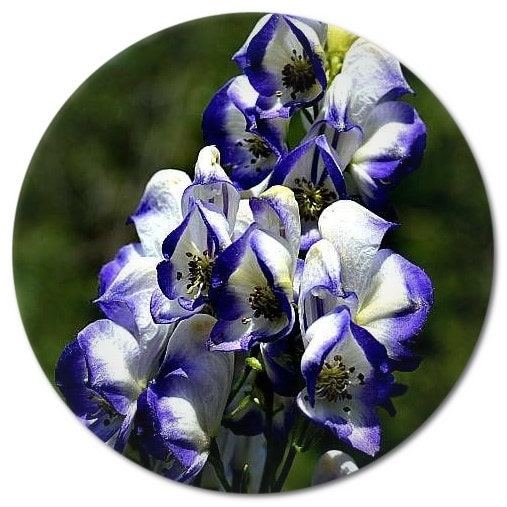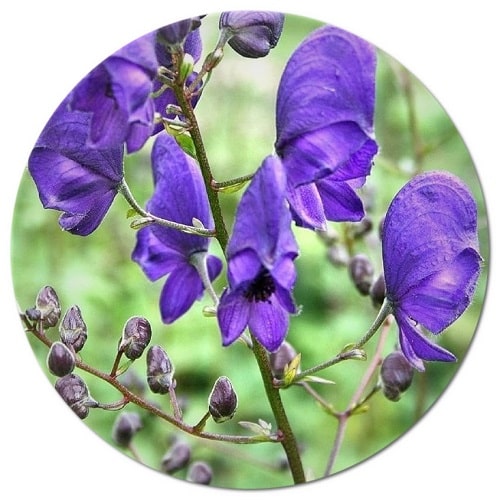Aconitum, commonly known as “aconite,” “monkshood,” or “wolfsbane,” is a genus of flowering plants belonging to the family Ranunculaceae. The genus includes several species of herbaceous perennial plants, and many of them are known for their distinctive hood-shaped flowers.
Key features of Aconitum plants include:
- Flowers: The flowers of Aconitum are often hood-shaped, which gives rise to the common name “monkshood.” The hood is formed by the upper sepal of the flower. The flowers can come in various colors, including shades of blue, purple, white, and yellow.
- Foliage: The leaves are typically deeply lobed or palmately divided and arranged alternately along the stems.
- Toxicity: Aconitum plants are highly toxic. They contain alkaloids, such as aconitine, which can be lethal if ingested. Proper caution should be taken when handling these plants.
- Habitat: Aconitum species are found in various regions, including mountainous areas, meadows, and woodland habitats. They are native to Europe, Asia, and North America.
- Cultural and Historical Significance: Aconitum has a long history of traditional medicinal use, but it is important to note that the plant’s extreme toxicity makes it unsuitable for self-medication. In folklore, it has been associated with both healing and poison, and it has been used in rituals and as a poison for hunting and warfare.
Due to its toxicity, Aconitum is not commonly grown in gardens for ornamental purposes. However, some gardeners with appropriate knowledge and precautions may cultivate certain non-toxic varieties for their unique and attractive flowers.

If you encounter Aconitum in the wild or consider growing it in a garden, it is crucial to exercise caution, wear gloves when handling the plant, and be aware of its toxic nature. Keep in mind that the sale and cultivation of certain Aconitum species may be regulated in some regions due to their potential danger.
What is the importance of Aconitum?
Aconitum, commonly known as “aconite,” “monkshood,” or “wolfsbane,” has historical and cultural significance, as well as certain uses in traditional medicine. However, it’s crucial to highlight that Aconitum is highly toxic, containing alkaloids such as aconitine, and should not be used without proper knowledge and caution. Here are some aspects of the importance of Aconitum:
- Traditional Medicine:
- Historical Uses: Aconitum has a long history of use in traditional medicine, especially in certain Asian cultures. It has been employed for its potential analgesic and anti-inflammatory properties.
- Toxicity Concerns: Despite its historical use, it is essential to emphasize that the plant is extremely toxic, and its medicinal use is strongly discouraged due to the risk of poisoning.
- Cultural and Folklore Significance:
- Symbolism: Aconitum has been associated with various symbolic meanings. In folklore, it has been linked to both healing and poison. Its striking hood-shaped flowers and toxic nature have contributed to its role in myths and legends.
- Magical Uses: In some traditions, Aconitum has been used in rituals and magic, believed to have protective or transformative properties. However, its use for such purposes is not recommended due to its toxicity.
- Historical Uses:
- Poison for Hunting and Warfare: Historical accounts indicate that certain cultures used Aconitum as a poison for hunting and warfare. The toxicity of the plant made it a lethal weapon when applied to arrows or spears.
- Ornamental Value:
- Garden Cultivation: Despite its toxicity, some non-toxic varieties of Aconitum are cultivated in gardens for their unique and attractive hood-shaped flowers. Gardeners need to exercise caution and choose non-toxic species.
- Conservation and Ecological Considerations:
- Habitat Importance: Aconitum species are part of various ecosystems, and their conservation is essential for maintaining biodiversity in certain regions.
It’s crucial to reiterate that the toxicity of Aconitum poses a significant risk, and any use of the plant for medicinal or other purposes should be avoided without proper expertise. Ingesting any part of the plant can lead to severe poisoning and even death. If there is a need for medicinal treatments or ornamental plants in a garden, safer alternatives should be considered. Always consult with healthcare professionals or botanists before considering any use of Aconitum.

How poisonous is Aconitum?
Aconitum, commonly known as aconite, monkshood, or wolfsbane, is highly poisonous. The entire plant, especially the roots, contains potent alkaloids, including aconitine, which are neurotoxins and cardiotoxins. Ingesting even a small amount of any part of the plant can be fatal.
The toxic effects of Aconitum include:
- Neurological Effects: Aconitine primarily affects the nervous system. It can lead to symptoms such as numbness, tingling, weakness, and paralysis.
- Cardiac Effects: Aconitine can cause severe disturbances in heart rhythm and function, leading to cardiac arrest.
- Gastrointestinal Effects: Ingesting Aconitum can lead to nausea, vomiting, abdominal pain, and diarrhea.
- Respiratory Distress: Breathing difficulties and respiratory failure can occur as a result of Aconitum poisoning.
- Death: In severe cases, ingestion of Aconitum can lead to rapid and fatal poisoning.
Due to its extreme toxicity, Aconitum has a dark history of being used as a poison for hunting and warfare. It is also known for its role in certain historical poisonings.
It is crucial to exercise extreme caution and avoid any contact with Aconitum plants. Individuals should refrain from handling the plant without protective measures, and under no circumstances should any part of the plant be ingested. Even skin contact with the plant can lead to irritation.
If there is any suspicion of Aconitum poisoning, it is an emergency, and immediate medical attention is required. Treatment may involve supportive care, administration of activated charcoal, and medications to counteract the effects of the toxins. The prognosis for Aconitum poisoning can be grave, and fatalities can occur rapidly.
Because of the high toxicity of Aconitum, its sale may be regulated in some regions. It is important to be aware of the potential dangers associated with this plant and to take appropriate precautions to prevent accidental exposure. If you have Aconitum in your garden, consider removing it or taking measures to ensure that it is inaccessible to children and pets.
